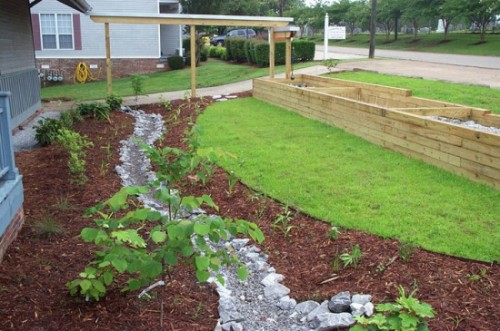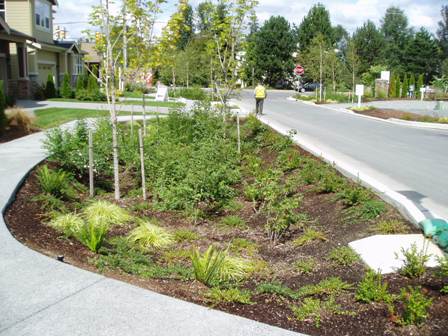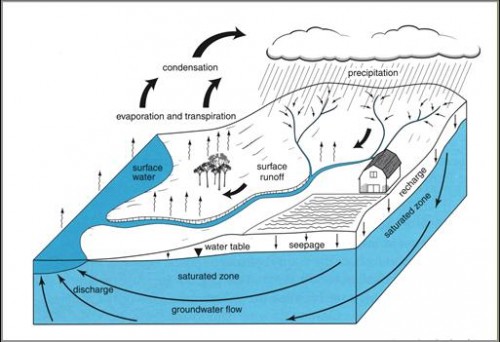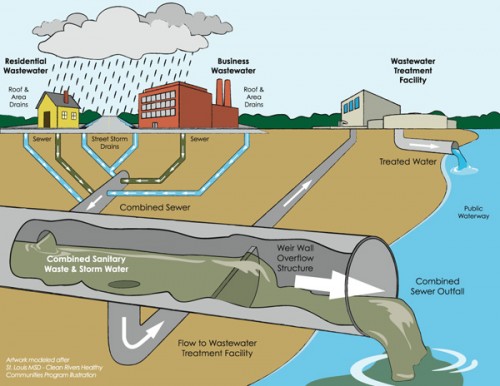Do you ever think about where all that water goes when it rains?
In a natural system, most rainwater gets absorbed in the ground where it falls. It gradually flows, or percolates, through the soil until it reaches the water table (the point in which an underground area is saturated with water.) As the water percolates through the soil, it gets filtered of contaminants like pathogens, pollutants, and silt. Gravity slowly pushes the groundwater to a retention area, a place that holds the water like a river, lake, or the ocean.
In an urban environment where rainwater falls on impermeable surfaces, surfaces that water cannot pass through like parking lots, the rain becomes runoff which flows over the impermeable surfaces picking up pollutants like lead and then directly into a manmade drain. This water flows through a city’s sewer system where it is eventually treated, which takes a lot of energy and money, and is then released (usually not entirely clean and with harmful chemicals like chlorine that are used to treat the water) into local waterways. During times of flooding, which are becoming more frequent in the Northeast, sewer systems become overwhelmed and cities are forced to release untreated, raw sewage into nearby rivers and oceans.
To reduce the damaging effects of flooding and wastewater overflow, urban dwellers should create more permeable surfaces like gardens, specifically ones with bioswales. A bioswale is a low-lying area designed to remove silt and pollution from runoff and to manage flooding.
Many considerations need to be taken when designing a bioswale:
- Location: must be in a low-lying area where water tends to collect.
- Gradient: flat areas or areas with a slope greater than 5% are not practical for bioswales.
- Drainage: use highly permeable mediums like gravel or coarse sands. Do not build a bioswale in an area with a high water table.
- Plants: choose plants that are both flood and drought resistant. Native plants are better because they do not need fertilizer, will handle the climate more heartily, and will increase biodiversity.
- Purpose: design your bioswale to solve a specific problem like flooding, high levels of nitrogen/phosphorus, pollution mitigation, or lack of biodiversity.
As an NY green contracting company with landscape design services, Eco Brooklyn can help you design and install a bioswale that will effectively resolve flooding problems, reduce the amount of contaminants entering local waterways, increase groundwater volume, and aid local biodiversity all while adding beauty to your backyard.


As part of the city’s plan to retrofit New York, a number of 5 x 20 ft bioswales will be built along city streets. Read more here.
Eco Brooklyn is planning on building a 5 x 13 ft tree planter that will act partly as a bioswale in the sidewalk outside the Green Show House. We are getting our applications in and revising our design so we hope the project will be underway shortly! More on that as we progress…
ADDENDUM: WATER CONTAMINANTS 101
- Silt: Silt is made up of fine particles of soil, sand, and dust. It is easily transported by runoff because it is so light. When silt enters a waterbody it tends to linger at the surface of the water and eventually settles at the bottom. Not only is the cloudy effect of silt unattractive, but it also blocks sunlight from reaching the aquatic plants inhabiting the water body. Without sunlight those plants will die, diminishing habitat and food sources for aquatic animal life. Aquatic plants also play a major role in adding oxygen to the water. Without them, water bodies can become anaerobic, devoid of oxygen, which makes them inhospitable to plant and animal life and undrinkable for humans.
- Phosphorus and nitrogen: These are the two elements that drive plant growth. Excess nitrogen (N) and phosphorus (P) enter groundwater mainly from fertilizer that gets washed away as runoff. Large amounts of N and P in waterbodies tend to support large algal blooms. Algae is microscopic and lives at the surface of the water. With enough sunlight, N, and P, blooms can become so large that, like silt, they can block sunlight from entering the water, starving the aquatic plants. When the algae eventually dies, it sinks to the bottom of the water where it will be decomposed, a process that uses up oxygen, thus subtracting further from the water’s oxygen levels. Further, some algal blooms can be toxic, harming the animal life around it, or can be ingested by fish then making them toxic for humans to eat. If you use fertilizer in your yard, consider using plants that have high-phosphorus absorption.
- Pathogens: A pathogen is a virus, bacteria, or other microorganism that can cause disease. Pathogens are most commonly introduced to water through agricultural runoff of manure and animal wastes.
- Pharmaceuticals: When we ingest drugs, traces of them are excreted in our urine. These chemicals make their way through the sewer system and into local water bodies. Scientists are not entirely sure how much of an impact pharmaceuticals really have in water systems. It has been suggested that increased levels of estrogen, which come from birth control pills, may be effecting sexual development of some aquatic animals.
- Heavy metals: Heavy metals enter the hydrosphere mainly through industrial practices like mining and smelting. Heavy metals are dangerous because in large quantities they can be poisonous to humans and animals. If your backyard has a lead problem, for example, use plants that absorb metals. Eco Brooklyn also offers soil remediation services.


